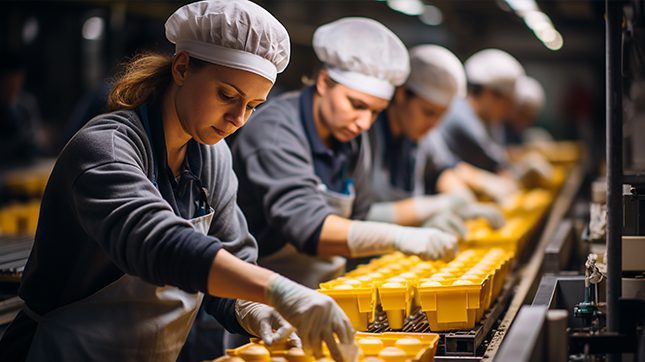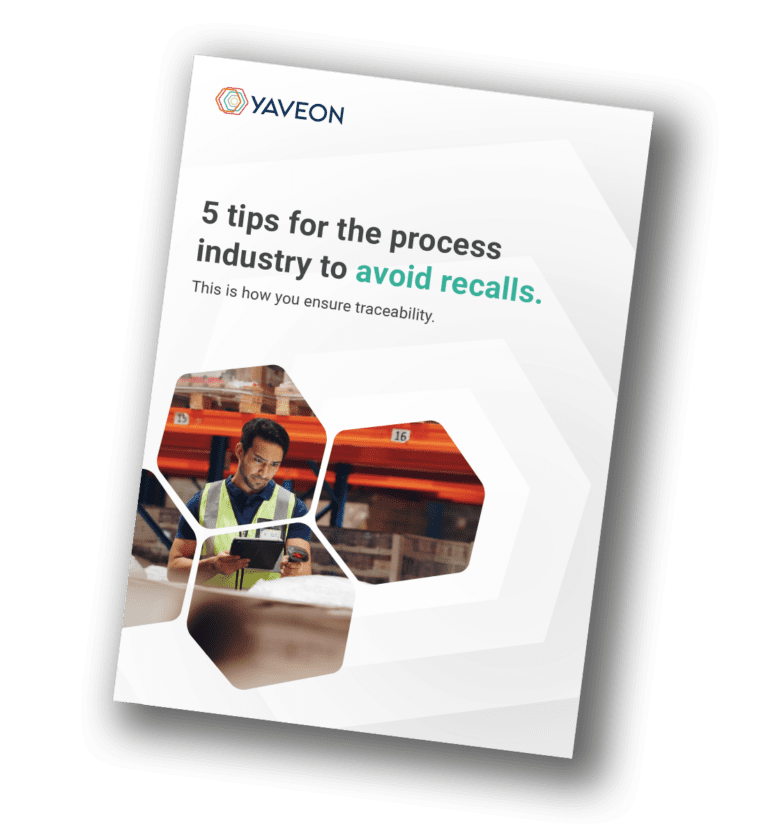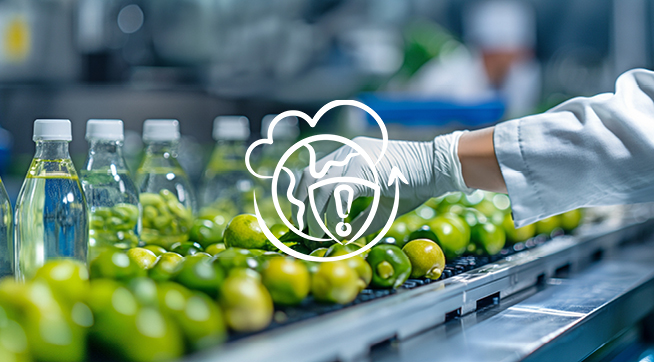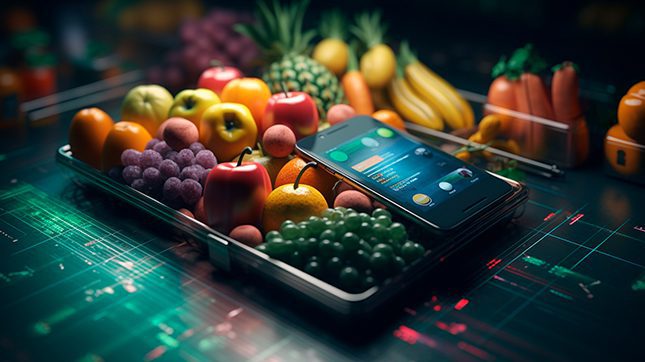Quality control for food
Quality control is an essential part of the food industry. Strict legal requirements, comprehensive testing methods and specialized software solutions help companies to ensure the highest standards of food quality - from production to the end consumer.

4. April 2025
Food quality means more than just complying with regulations. It influences the health and confidence of consumers. Only if food and beverages meet strict requirements in terms of taste, texture, nutritional values, shelf life and safety can they be convincing in the long term. Companies in the food industry have an enormous responsibility - a responsibility that does not end with production.
But what does effective quality control look like? Which inspection methods are crucial and how can digital solutions support companies in this? We answer precisely these questions in this article.
What is involved in food quality control?
microbiological tests (e.g. salmonella, E. coli).The quality control of food and beverages covers the entire supply chain - from raw material control to production and final inspection. Only those who set the highest standards right from the start can score points with retailers and customers in the long term.
When we talk about food quality, we mean sensory, physical, chemical, microbiological, nutritional and ethical properties and characteristics. As these have an impact on the safety, taste, appearance and nutritional value of food, they are very important to consumers.
What does food quality mean?
Food quality encompasses sensory, physical, chemical, microbiological and nutritional properties. These directly influence safety, taste, appearance and nutritional value and are therefore essential for consumers and manufacturers.
However, the definition of food quality varies depending on the perspective:
- Consumers value taste, freshness and nutritional value.
- Authorities focus on compliance with legal requirements and safety standards.
- In addition to quality, companies must also consider cost-effectiveness, durability and production standards.
Clear, transparent criteria are needed to objectively assess the quality of food and ensure long-term trust in brands and products.
Typical test procedures in quality control
Quality control includes various test methods:
The quality check is carried out in several steps:
- Pre-production inspection (PPI): Inspection of raw materials before processing. Typically at goods receipt or with the purchase order.
- Inspection during production (DPI): Ensuring consistent quality throughout the entire manufacturing process. The so-called in-process control (IPC).
- Pre-shipment inspection (PSI): Final inspection before delivery to the retailer.
These multi-stage tests help to identify quality defects at an early stage and avoid recalls or reputational damage. Because quality that inspires creates trust that lasts.
No more recalls! Professional tips for the process industry.
Traceability is the key to safe production. If you don't guarantee it, you risk recalls that cause a loss of image, penalties and a slump in sales. Our tips reveal how you can avoid these risks. Read now!

Laws and regulations: What are the requirements?
Legal requirements check and ensure that the regulations for the quality control of food and beverages are complied with. Particularly important framework conditions and guidelines are:
EU regulations
EU regulations define the general and specific requirements for food hygiene, the handling of animal by-products, contaminants in food, additives, flavorings and enzymes, novel foods, genetically modified foods, traceability and the rapid alert system.
Some of the most relevant EU regulations in this area are:
Regulations of the Food and Drug Administration (FDA)
The FDA's regulations set standards for the safety and quality of food in the USA. These also include good manufacturing practice (GMP), preventive controls, food safety modernization, nutritional and allergen labels and the import of food.
Codex Alimentarius Commission
The Codex Alimentarius Commission develops globally recognized standards, guidelines and recommendations for food safety and quality. The aim is to protect the health of consumers, prevent unfair trading practices and strengthen international cooperation. To this end, the association deals with issues such as food hygiene, contamination, additives, pesticide residues and veterinary medicines.
Regardless of which specification or framework condition is used: They apply to all players in the food chain. If the national and international monitoring and control systems detect violations, sanctions will be imposed. This can result in fines and product withdrawal as well as the closure of businesses or criminal prosecution.
Who is responsible for inspecting food?
Food control is ensured by various players. They monitor the quality and safety of products through regular audits, inspections and testing procedures.
Operations (self-regulation):
Food manufacturers must comply with legal requirements, establish quality controls and implement processes such as HACCP, traceability and supplier evaluation.
Food monitoring authorities:
Authorities check whether hygiene and labeling regulations are complied with, take samples and impose sanctions in the event of violations.
External testing institutes:
Independent laboratories carry out residue analyses, certifications (ISO, IFS, BRC) and sensory tests for quality control.
Consumers:
They play a role by assessing the quality of food and reporting anomalies to manufacturers or authorities.
This interaction ensures that food meets the highest quality and safety standards.
Industry-specific differences in quality control
Every food industry has specific requirements:
-
Meat industry
The meat industry sets high standards for animal health and welfare, slaughtering and product traceability. In addition, particularly strict hygiene regulations apply in order to prevent pathogens such as salmonella or E. coli.
-
Dairy industry
The dairy industry must guarantee the quality and safety of raw milk and its products, such as cheese and yoghurt, and ensure that the cold chain is maintained.
-
Bakery industry
The baked goods industry is obliged to ensure the freshness, aroma, consistency and shelf life of its products. In addition, the composition and ingredient labeling must be complied with, especially with regard to allergens.
-
Beverage industry
The beverage industry is obliged to check the quality and purity of raw materials such as water, fruit, grain and hops. The same applies to the end products, for example juice, beer or wine, for which fermentation, filtration, pasteurization and bottling must also be monitored.
Software for quality control: How does an ERP system help?
Modern software makes quality control in the food industry much easier. It ensures that automated quality checks are seamlessly integrated into the production process, test reports and certificates are fully documented and batches can be traced from the raw material to the end product. It also helps with supplier evaluation by automatically evaluating quality data and supports companies in complying with international standards such as HACCP and ISO22000 - thus avoiding violations and sanctions.
The ERP industry solution from YAVEON brings all of this together in one central system:
- Automated quality controls - Smooth inspection processes for incoming goods, production and final inspection, among others.
- Traceability & batch management - full transparency across the entire supply chain.
- Live data & real-time analyses - Fast response to quality deviations.
- Audit & certification management - support for HACCP, ISO22000 and other standards.
With the ERP industry solution from YAVEON, companies can keep an eye on the quality of their products at all times - for maximum safety and efficient, legally compliant production.
In the food industry, every detail counts - from raw material testing to final inspection. Companies must meet high standards, design efficient processes and ensure traceability.
Find out more about our ERP industry solution for the food industry!






